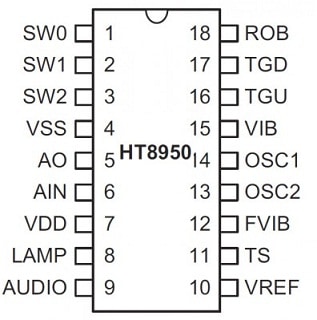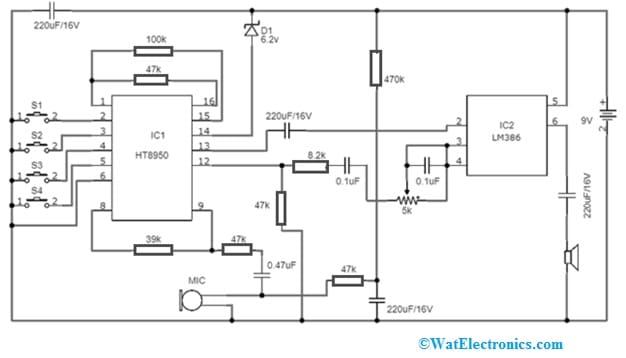A voice modulator is an integrated circuit that changes the tone and pitch of a voice. An example of a voice modulator IC is HT8950 IC which can make seven steps down or up on the 8 Hz frequency of input voice. Thus, the modulator circuit using this IC uses different components, so it picks the input voice by using a microphone and pushbutton switch to step up the frequency, and the IC amplifies the output. Thus, this IC can be used in electronic systems like speech processors, telephones, toys, etc. So, this article elaborates on a voice modulator IC like HT8950 IC, pinout, specifications, and its applications.
What is HT8950 IC?
The HT8950 is a CMOS LSI voice modulator IC that provides seven steps to move the input voice frequency to generate a dramatic change within the output. So, the HT8950 IC has an in-built microphone amplifier through an 8-bit A/D converter, an internal bias, an in-built SRAM, and an 8-bit current output type D/A converter. So, these converters with an 8 kHz sampling rate ensure a high quality and high S/N ratio o/p voice. This IC includes an LED indicator that flashes by the volume of input voices.
HT8950 IC Works?
The HT8950 voice modulator IC works by changing the input voice frequency and giving a different output voice. So this IC has two special effects vibrato & robot where the vibrato effect is generated by changing the input signal frequency up and down at an 8Hz rate. Alternatively, the robot function changes a voice from input to a robot voice. So these two effects can be chosen based on which pin of IC is activated either VIB or ROB.
The chip provides seven steps mainly for the o/p frequency level shifting and it can be chosen from the two pins groups like SW0, SW1 & SW2 mainly for electronic direct choice and ROB, TGD, TGU & VIB mainly for push button selection.
HT8950 IC Pin Configuration:
The HT8950 IC pin configuration is shown below. So this IC includes 18 pins which are discussed below.

HT8950 IC Pin Configuration
- Pins – 1, 2 & 3 (SW0, SW1 & SW2): These are function setting pins of IC.
- Pin-4 (VSS): It is a negative power supply or GND pin of IC.
- Pin-5 (AO): It is an internal amplifier output pin of IC.
- Pin-6 (AIN): It is an input pin of an internal amplifier.
- Pin-7 (VDD): It is a positive power supply pin of IC.
- Pin-8 (LAMP): It is a lamp output pin where brightness will be changed with voice volume.
- Pin-9 (AUDIO): It is an audio output pin of IC.
- Pin-10 (Vref): It is the reference voltage of an internal amplifier.
- Pin-11 (TS): This pin is used for IC tests only.
- Pin-12 (Fvib): It is a vibrato frequency control pin of IC.
- Pin-13 (OSC2): It is an oscillator output pin of IC.
- Pin-14 (OSC1): It is an oscillator input pin of IC.
- Pin-15 (VIB): This pin switched to Vibrato mode.
Features & Specifications:
The features and specifications of HT8950 IC include the following.
- HT8950 is a CMOS LSI single-chip voice modulator IC.
- It is available in 16-pin or 18-pin DIP packages.
- Its operating voltage ranges from 2.4V to 4.0V.
- It has an On-chip SRAM.
- This IC has two special functions; Robot and Vibrato.
- It has 8 kHz sampling rate
- It provides 7-step level shifting
- This IC includes 8-bit A/D & D/A converters.
- It has an LED indicator including voice level.
- It uses minimal external components.
- This IC has a push button selection (or) electronic mode.
- The HT8950 IC operating temperature ranges from -20°C to 70°C.
- Its storage temperature ranges from -50°C to 125°C.
Equivalents & Alternatives :
The equivalent HT8950 IC is HT8950A. Alternative voice modulator ICs are; MK171, PT2361, LM1496, HT82V733, etc.
Digital Voice Changer with HT8950 IC
A digital voice changer with HT8950 IC is a simple circuit mainly for people who are very interested in electronics & changing sounds. So the required components to make this circuit mainly include; a 9V battery, HT8950 IC, LM386 IC,6.2V Zener Diode, resistors like; 47k, 100k, 39k, 8.2k, 4.7k & 470k, variable resistor 5k, polar capacitors like 220u & 47u,0.1uF nonpolar capacitors -0.47uF, Electret Mic, 8-ohm speaker, switches, etc. So connect this circuit as per the circuit diagram shown below.

Digital Voice Changer with HT8950 IC
Working
The digital voice changer circuit diagram includes an amplifier, converters like A/D and D/A, an audio amplifier, and static RAM. So the user’s voice can be captured with an electret microphone which is given to the internal amplifier. After that, the voice signal can be digitized and stored within a static RAM. So, it can be transmitted to a latching register then the speech signal shifts into a D/A converter, wherever it can be reset to its unique analog form (or) shifted frequency spectrum. Thus, this speech signal can be transmitted throughout a network to an audio amplifier after that to the speaker to make it audible.
This digital voice changer circuit uses a voice modulator technology that processes the received voice signal digitally. After that this signal’s frequency spectrum can be shifted in seven incremental steps, then the output can be changed to thinner or sound thicker within frequency.
The voice modulation process is analogous to modifying the playback recorded voice speed on tape, apart from that it does not deform the speech or change its speed. Additionally, this circuit includes two sound effects that change the voice into a robotic or tremulous one. So an electret microphone input receives the voice and the output can be played throughout a dynamic speaker. So the whole system can be operated on a 9V battery.
Please refer to this link for the HT8950 IC Datasheet.
Advantages & Disadvantages
The advantages of HT8950 IC include the following.
- The HT8950 IC provides an 8-bit A/D & D/A converter with an 8 kHz sampling rate, ensuring a high-quality voice o/p with a high S/N ratio.
- This IC provides two special effects vibrato & robot.
- It provides high input impedance by allowing minor timing capacitors, longer timing cycles, and high speed with 400ns typical cycle time.
- It can shift an input voice frequency within seven steps.
The disadvantages of HT8950 IC include the following.
- The main drawback is that the voice assistants like a channel provide fewer enriching interactions as compared to other platforms.
- This IC may give unwanted noise (or) artifacts into the sound.
- The vibrato effect can be produced whenever the IC moves automatically the input signal pitch up & down alternately at the 8 Hz frequency.
Applications
The applications of HT8950 IC include the following.
- The HT8950 IC can be utilized in educational toys & different leisure products.
- This IC can be used within audio systems, recorders, mixers, speech systems & telephone systems.
- This IC is used by some users to design guitar effects pedals.
- This IC is mainly designed and used for voice modulation.
- These ICs are used in different toys, recorders, mixers, speech systems, audio systems, telephone systems, etc.
Thus, this is an overview of HT8950 IC, pinout, features, specifications, circuit, working, pros, cons, and its uses. So this is a voice modulator IC that creates special effects mainly for audio & speech processing applications. This IC has seven steps to change the input voice’s frequency. HT8950 IC has in-built components like an 8-bit A/D converter, a microphone amplifier, an 8-bit D/A converter, and a built-in SRAM. Thus this IC has two special effects vibrato & robot where the vibrato effect changes the input signal’s frequency at a rate of 8Hz. And, the robot function changes the i/p voice into a robot voice. This chip includes an LED indicator that blinks based on the input voice’s volume. So here is a question for you, what is LM1496 IC?